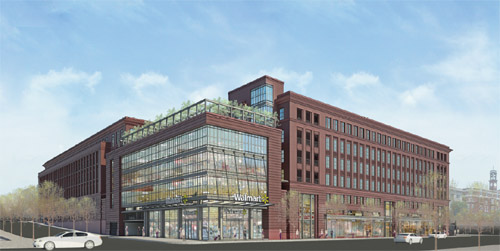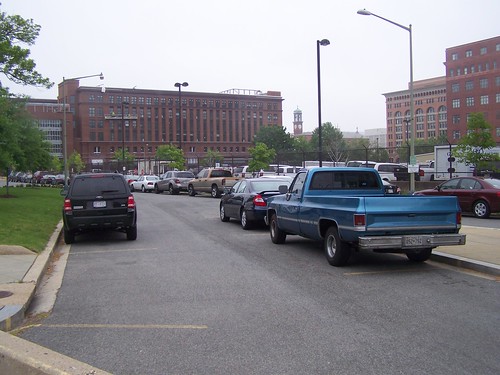I hope for Aspen Hills' sake that Montgomery County is smart enough to learn from DC's planning errors with regard to Walmart's entry
Image of the Vitro Building in Aspen Hill from the Gazette.
The Examiner ("Opponents call Montgomery County vote 'fast-tracking Walmart'" and "Montgomery's dilemma: Walmart or empty hulk?") and Gazette ("Proposed Wal-mart site designed for unique tenant: Proposed Aspen Hill Wal-mart site was designed for specific tenant" and "Aspen Hill residents take sides on planned Walmart: Civic Association will discuss issue next month") have stories on how the Montgomery County Planning Board got approval from the Montgomery County Council to proceed with consideration for a zoning change for a parcel of land in Aspen Hill without having to go through a full master planning review and update process.
1. This is somewhat controversial because the property is a vacant office building (see the 2010 Gazette story, "BAE Systems to leave Aspen Hill property by late June"), empty for almost three years, and concerned residents would prefer that the site be redeveloped instead of just sitting there.
The developer argues that there isn't demand for office, which is the zoning for the property. (And note that in Silver Spring, more properties are being redeveloped as residential, because of a drop in demand for office space. See "Silver Spring commercial plans shifting to residential" from the Gazette.)
2. It's also controversial because the developer proposes a Walmart, and Walmart for reasons that have been covered here in great detail, is controversial (they just launched a new image campaign, see "Will Consumers, Hourly Associates Buy 'The Real Walmart'?" from RetailWire), especially in communities with strong unions (typically grocery store employees are represented by unions, and Walmart workers are not), because it can lead to store closings by unionized firms.
3. Resident desperation is something that developers like, because it allows them to build something, not necessarily something good, because people's concerns for quality get beat down over time in the face of nothing happening (counter that to the piece the other day about the saga of the BP gas station vs. the 215 unit apartment building + a Giant Supermarket on H Street NE, which was ultimately a 13-year process).
4. But because the use change for the site requires a change to zoning, this does give the county some leverage to push the developer to do something "better" rather than merely the minimum that's allowed.
My understanding is that the preference is for a mixed use project, even though the site is more than 2 miles from the Glenmont Metro Station. Then again, high capacity transit station access is not an absolute requirement for mixed use--it comes down to market demand and opportunity.
5. What are the lessons from DC? ("Lessons from Walmart's foray into Washington, DC")
- how to develop a property is a different decision from what type of use goes there
- the animus with regard to Walmart gets people all worked up and rash and therefore they deal with neither issue--how to develop versus the use--very well and Walmart and developers know this and use it to their advantage
- Walmart is now willing to consider mixed use properties, but ultimately they don't care how a site is developed so long as the location meets their preferences (so don't go to Walmart expecting them to advocate for your desires for mixed use)
- so ultimately whether or not a site with a Walmart is developed as a vertical mixed use project or a single site project is up to the developer
- with the suasion power of the local government planning and zoning process
Unlike many jurisdictions, DC doesn't have a "Big Box Review Ordinance." Fortunately, Montgomery County does have such an ordinance, which gives them more capacity for review.
However, it does not address what people call "community benefits" issues, wage and other elements, which some activists and unionists think that such stores should have to provide. (I don't necessarily, see "What community benefits are supposed to be versus what people think they are about.")
In both Montgomery County and DC there have been initiatives to create such requirements for big box stores, because of Walmart, although sadly there has been no initiative to create a "big box ordinance" or related planning and building regulations in DC.
6. In short, the focus needs to be on Lee Development Company, the owner of the Aspen Hill site, and no one else (definitely not Walmart) in order to get the best possible mixed use result.
7. In DC, sadly, reporting on a couple of the "good" Walmart store proposals within vertical mixed use projects has overshadowed the fact that half to two-thirds of the sites in DC will either be single site stores or horizontal mixed use. 2 out of 6 isn't very good. It's terrible (except in baseball).
The development of the 1st and New Jersey Avenue NW site that will have a Walmart demonstrates that high quality mixed use urbanism with a big box--even a Walmart--is possible. And it also shows that settling for sub-par urbanism at most of the sites will disserve DC for many decades.
Hopefully Montgomery County won't make the same mistake.
Proposed rendering for the Fort Totten Store (the company got their financing to go forward a couple weeks ago, see "Financing secured for Wal-Mart-anchored Fort Totten Square" from the Washington Business Journal)

Single use Walmart on a 4 acre site on Georgia Avenue NW

The 1st and New Jersey Avenue NW site under construction

Building under construction
Rendering


More than most, JBG, the developer of this site, respects context and developed a project that took its design and architectural cues from the buildings around the site, which include the Government Printing Office--the first building was constructed in the 1860s--which is shown in the far right of this photo. The building to the immediate left of the GPO was constructed in the late 1980s, and also took its design cues from the GPO building.
Labels: community benefits, formula retail, mixed use development, protest and advocacy, real estate development, urban vs. suburban, zoning




1 Comments:
A debt of gratitude is in order for your glorious posting! I very delighted in understanding it.
Post a Comment
<< Home